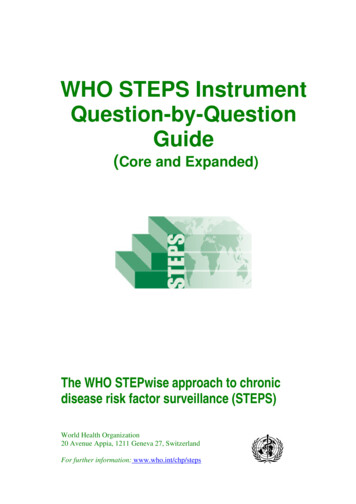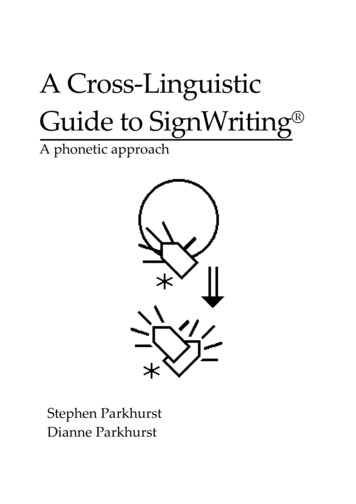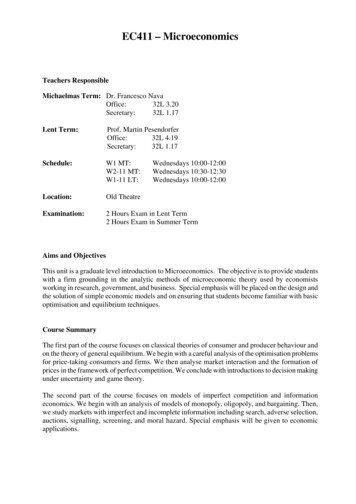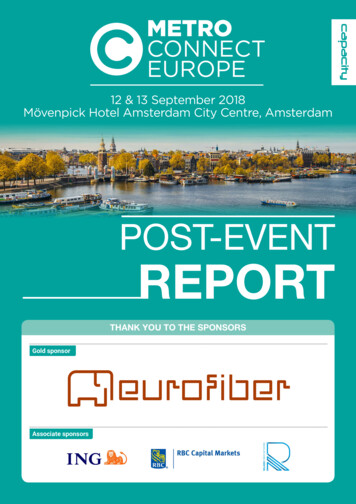
Transcription
LSE ‘Europe in Question’ Discussion Paper SeriesThe Role of EU Integration inAccelerating Structural Reforms inthe Western Balkans: Evidence,Theory and PolicyFatmir Besimi & Vassilis MonastiriotisLEQS Paper No. 140/2019January 2019
Editorial BoardDr Bob HanckéDr Jonathan WhiteDr Sonja AvlijasMr Sean DeelAll views expressed in this paper are those of the author and do not necessarily represent theviews of the editors or the LSE. Fatmir Besimi & Vassilis Monastiriotis
The Role of EU Integration in AcceleratingStructural Reforms in the Western Balkans:Evidence, Theory and PolicyFatmir Besimi* & Vassilis Monastiriotis**AbstractIntegration with the European Union has been an important driver of economic, political andsocial transformation in the Western Balkans. In recent years, however, the pace of structuralreforms in the region has decelerated and the trend of economic catch-up seen in the 2000shas not resumed after the slowdown of the global economic crisis. This has coincided – atleast temporally, if not causally – with a ‘temporary freeze’ in the EU’s enlargement towards theregion. Against this backdrop, this paper seeks to investigate the role of EU conditionality oneconomic reforms and convergence in the Western Balkans. To do so, it provides original, albeitdescriptive, empirical evidence showing a strong link between EU-related structural reforms(towards the Copenhagen Criteria) and economic growth; and subsequently presents ananalytical model demonstrating the mechanisms of policy decisions for reforms under EUconditionality. The model assumes away sectoral interests, policy uncertainty and coordinationproblems, allowing the analysis to focus specifically on the tension between two objectives:the pursuit of EU accession, through the implementation of jointly agreed reforms, and theaccommodation of domestic policy concerns (maintaining policy stability and public support).Our results unveil a policy dilemma for the EU, having to choose between maximising thereform effort and minimising non-compliance. Drawing on this model, we discuss extensivelythe policy options that the EU faces in trying to enhance the reform performance, growthtrajectories and, ultimately, European perspective of the countries in the region.Keywords:Structural reforms, European integration, Political Economy, EconomicconvergenceJEL Codes:F02, F15, P16, O47** South East European UniversityEmail: f.besimi@seeu.edu.mk** London School of Economics and Political ScienceEmail: v.monastiriotis@lse.ac.uk
Table of Contents1.Introduction . 12.Structural reforms and reform delays . 43.Empirical evidence . 74.A model of endogenous reform delays . 134.1. Model setting . 144.2. Equilibrium . 165.Extensions. 195.1. Direct disutility from reforms. 195.2. Endogenous status quo bias . 205.3. Pro-reforms governments. 226.Policy options for the EU . 237.Conclusions . 28References . 32Appendix . 37AcknowledgmentsThe authors are grateful to Alberto Alesina for his valuable comments on an earlierversion of the model presented here and to Geoff Pugh, Aleksandar Stoijkov andDragan Tilev for their comments and suggestions on the empirical analysis. This workstarted during Fatmir Besimi’s Visiting Senior Fellowship at the LSE Research unit onSoutheast Europe (LSEE) in 2016-2017; while part of it was conducted when VassilisMonastiriotis was Visiting Scholar at the Centre of European Studies at HarvardUniversity in 2017-2018. We are thankful to faculty at both institutions for theirhospitality and their comments on earlier versions of this paper. Vassilis Monastiriotisalso acknowledges financial support by the Hellenic Observatory.
Fatmir Besimi & Vassilis MonastiriotisThe Role of EU Integration in AcceleratingStructural Reforms in the Western Balkans:Evidence, Theory and Policy1. IntroductionFor over six decades the European Union has contributed to the advancement of peaceand reconciliation, democracy and human rights in Europe. In this context, Europeanenlargement has played a significant role in integrating and democratising thetransition countries of Central and Eastern Europe. With some problems initially, thisproved to be true also in the Western Balkans, where the EU contributed towardspeace and stability after decades of conflicts, among others, mainly due to the promisefor a better future with political stability and economic prosperity.However, recent developments in the European Union, with the Eurozone crisis andthe rise of Euroscepticism, as well as in the Western Balkans, with the politicalchallenges that emerged recently (Carpenter, 2017), raise questions about the pace andcredibility of the EU integration process in the Western Balkans.1 A recent paper byThe crisis also unveiled other problems with EU conditionality, not least with regard to thedemocratic legitimacy of structural reforms imposed under fiscal consolidation programmes,which have tested the democratic institutions in some countries especially in the Eurozonesouth. Notwithstanding the importance of this issue, our focus in this paper is specifically withthe problems of conditionality and adaptation in the Western Balkans, given the stated sharedobjective by the counties in the region for political approximation and economic integrationwith the EU, i.e., without questioning the premises underpinning the enlargement process.11
Structural Reforms in the Balkansthe European Parliament’s Policy Department makes this clear: “Despite initialsuccess, the current approach to enlargement has reached its limits, as it seems to beslowing down the integration process rather than accelerating it. In the meantime, inaddition to the democratic and economic setbacks in the region, renewed tensions arethreatening to undermine fragile regional stability. Moreover, the EU’s unfinishedbusiness in the Balkans opens the door to various political, economic and securityalternatives [ ] The current autopilot mode of enlargement cannot continue.” (DGEP,2015). Indeed, according to international reform indicators, in recent years the pace ofstructural reforms in the Western Balkan countries has slowed down and catching-upafter the global economic crisis is slower compared to the New Member States (IMF,2015a).Seen from the Western Balkans perspective, besides the delays, EU integrationrepresents the best perspective – as stated also by DGEP (2015): “Even though thestrength of the EU anchor has been diminished by both the internal problems of theEuropean Union and the fact that full membership for Western Balkans countries isclearly a long way off, EU approximation is advancing and still represents the besthope for institutional reform.” Accordingly, we may say that EU enlargement towardsthe Western Balkans needs to be accelerated. Additional efforts need to be taken fromboth sides, the countries of the region and the European Union, to completesuccessfully the process of European integration and economic modernisation for theWestern Balkans.At the same time, however, EU enlargement passes through the implementation of alarge programme of structural reforms and institutional change in the region. This iswidely acknowledged in policy documents, which regularly highlight the interplaybetween domestic structural reforms and the EU association process. For example, inits 2015 Enlargement Strategy the European Commission was arguing that“[e]nlargement needs to be understood as a process which supports reform and thefundamental changes needed to meet the obligations of EU membership. [ ]Enlargement can only be of benefit to the EU and to partner countries if there is genuine,2
Fatmir Besimi & Vassilis Monastiriotissustainable reform.” (COM, 2015, p.4; emphasis added). In the latest EU EnlargementStrategy (COM, 2018a, p.1), the European Commission put this more boldly: “It isimportant to recognise that accession negotiations are not – and never have been – anend in themselves. They are part of a wider process of modernisation and reforms”(emphasis in the original).This reform agenda in the Western Balkans is pursued via a number of channels.Formally, the region benefits from a coordinated policy framework to structuralreforms, under the SEE2020 Strategy which, mirroring the Europe2020 goals, aims atachieving “smart, inclusive and sustainable” growth for each country in the regionwith good governance institutions and deeper economic integration (RCC, 2016). Inthe economic sphere reforms are also pursued under the free trade agreement of theregion, CEFTA (Thomas and Bojicic-Dzelilovic, 2014). Other, more EU-centredprocesses, however, are much more central for the reform agenda in the region (Uvalic,2019) as they link more directly to EU pre-accession conditionality – including theStabilisation and Association process and, more recently, the Berlin process with itspromotion of a Regional Economic Area for the Western Balkans (Sanfey andMilatovic, 2019).Despite this policy activism, there is wide recognition that the intensity of reforms andpolicy commitment to these has subsided in the region. This is reflected in the almostagonizing call by the European Commission in its latest EU Enlargement Strategydocument for “[t]he governments of the enlargement countries [ ] to embrace thenecessary reforms more actively and truly make them part and parcel of their politicalagenda – not because the EU is asking for it, but because it is in the best interests oftheir citizens.”It is not difficult to argue that overcoming these problems requires a deeperunderstanding of how the EU integration process helps accelerate structural reformsand what the impediments to this may be. This paper aims to contribute in thisdirection, by providing fresh evidence about the role of EU integration for economic3
Structural Reforms in the Balkansgrowth and institutional upgrading; and by developing a simple but informativemodel showing how the EU can act both as a ‘reform accelerator’ and as a source ofreform delays in the presence of a slow accession process and domestic resistances toreform. Given the slowdown of structural reforms and of economic growth in the postcrisis period, and the slowdown in the EU integration process of the Western Balkans,these contributions help us derive interesting policy conclusions for accelerating thereform process in the Western Balkans and, through this, facilitating higher economicgrowth and faster catch-up to the EU living standard.The remainder of the paper is structured as follows. In the next section we reviewselectively the literature about the link between the EU integration process andprogress with structural reforms. In section three we provide some empirical evidenceon this link, drawing on the experience of the New Member States and contrasting thisto that of the Western Balkans. In section four we develop a theoretical model whichshows how the EU can act as an anchor for reforms but also how EU involvement leadsto (perceived or real) reform delays under the presence of status quo bias by the public.In section five we follow through three interesting extensions of the model, whichallow us to introduce different assumptions concerning preferences towards reformsby the government and the public. Section six discusses the policy implicationsemanating from the model, identifying a number of policy areas where the EU, as wellas national governments, can place increased emphasis and take increasedresponsibility. The last section summarises and concludes.2. Structural reforms and reform delaysFollowing the global financial crisis and the problems that emerged with theeconomies of the Eurozone, the issue of structural reforms has re-emerged in theinternational policy agenda. Within the European Union, structural reforms are todaybelieved to be not only important for long-run growth but also essential for “the abilityof economies to adjust to shocks” (Canton et al., 2014, p.1). A clear agenda and4
Fatmir Besimi & Vassilis Monastiriotisprocedures for structural reforms have been developed subsequently, in part throughthe European Semester (COM, 2017; Campos et al, 2018a).In the case of transition countries and countries belonging to the EU pre-accessionprocess – such as those of the Western Balkans – calls for deeper and faster structuralreforms have been perhaps more emphatic, owing in part to a realisation that the paceand commitment to reforms in these countries has subsided after the crisis (EBRD,2013; Kovtun et al, 2014; IMF, 2015a). For example, already in 2013 the EBRDTransition Report was claiming that “structural reforms continue to face seriousobstacles” and that “the economic downturn has eroded popular support for reforms”.Similarly, in its 2015 Special Report on the Western Balkans the IMF also claimed that“the process of structural transformation began to stall in the mid-2000s, in the face ofvested interests and as reform fatigue set in, and remains incomplete”, adding that“[e]mbarking anew on deep structural reform is a key policy priority for the region”(IMF, 2015a, p.9); while in its 2016 assessment of the Western Balkans, the EuropeanCommission has acknowledged that, across the region, “structural shortcomingspersist, notably in the key areas of rule of law and the economy” (COM, 2016a, p.2).Last, in its recent Regular Economic Report on the Western Balkans, and despite seeingoverall a positive outlook for reforms in the region, the World Bank also emphasisedthat it is “important to accelerate the pace of structural reforms to boost medium-termgrowth” (World Bank, 2017a, p.22).In the particular case of the Western Balkans, of course, the issue of reforms isparticularly complex as it links to wider political, institutional and societal changesand well as to the very accession process (EU enlargement) and thus to themechanisms of EU conditionality.2 Indeed, a large literature exists that discusses theproblems of institutional transformation and political and economic reforms in theregion exactly under the prism of pre-accession conditionality and the so-called ‘EUAs noted recently in an EBRD publication, “the long-term EU perspective is a major plus anda unique quality of the region compared with other emerging markets, as it helps to anchormarket-oriented reforms and European standards” (Sanfey et al., 2016).25
Structural Reforms in the Balkanstransformative power’ (Grabbe, 2006 and 2014; Gateva, 2015). Drawing from earliercontributions concerning the experience of the 2004 Enlargement (Hughes et al, 2004;Schimmelfennig and Sedelmeier, 2005) and building on earlier analyses about theproblems of transition in the region (Kuzio, 2001; Anastasakis and Bechev, 2003), thisliterature attributes the origins of reform delays, or reform failures, in the region ontwo sets of factors. On the one hand, problems emanating from the side of the EU,including its ‘ambivalence’ (lack of clarity with regard to the rules of EU accession orof commitment to enlargement – Grabbe, 2014; Börzel and van Hüllen, 2014), itsinattention to local institutional conditions and to buying-in local actors and elites(Noutcheva, 2009; Vachudova, 2014), and its reform targets which may be too strict orunrealistic (Uvalic, 2012; Noutcheva and Aydin-Düzgit, 2012). On the other hand,problems specific to the region, such as the unresolved ethnic and statehood issues(Borzel, 2016), vested national and sectoral interests (Vachudova, 2014) and theabsence of a “robust local demand for change towards Europeanisation” (Noutchevaet al., 2013).These issues noted, the wider literature recognises that the EU is a significant stimulusfor growth and convergence for associated countries. The substantial institutionaltransformation, fast economic restructuring and sustained income growth of the CEEcountries provides ample evidence for this (for recent causality inferential evidence onthis see, inter alia, Monastiriotis et al, 2017, and Campos et al., 2018b). In this regard,it is widely acknowledged that the EU has not only an autonomous effect on growthfor the associated countries (e.g., through economic integration and membership) butalso, if not most importantly, by incentivising structural reforms.This creates a puzzle: if the EU association process is growth-enhancing, bothautonomously and via the facilitation of structural reforms, then why is it that we seesignificant reform delays and ‘fake’ compliance (as identified in the academic politicalscience literature) or significant reform gaps and decelerating reforms (as identified inthe economics and policy analyses)? If reforms are both growth-enhancing and aprecondition for accession, shouldn’t national governments be pursuing (and6
Fatmir Besimi & Vassilis Monastiriotisimplementing) reforms more actively and faster? In the political economy literatureproblems of reform delays and non-compliance are generally associated with varioustypes of political market failures, not only related to corruption and capture (Innes,2014) but also related to problems of institutional quality (see, inter alia, Acemoglu etal., 2005; Aghion et al., 2005; Ciccone and Papaioannou 2009), distributive politics (e.g.,Alesina and Rodrik, 1994), or even pure information and coordination problems (e.g.,time-inconsistency – Kydland and Prescott, 1977; or status-quo bias – Fernandez andRodrik, 1991). As noted, the literature on EU conditionality in the Western Balkansemphasises instead problems of external policy design (misfit, inconsistency) andproblems of domestic compliance (Dzankic et al, 2019).In this paper we provide a bridge between the two literatures, by developing ananalytical model offering an exposition of the problem of delayed reforms and reformgaps in the Western Balkans under the stimulus of the EU. Our model incorporatesfeatures appealing to the EU conditionality literature, such as the role of the EU as ananchor to shift reform priorities, and ones more formally addressed in the widerpolitical economy literature, such as reform resistance associated with status quo bias– as well as assumptions consistent with the evidence in the empirical literature ofreforms, which shows structural reforms to have significant short-run costs despitetheir long-term welfare benefits (see, inter alia, Babecky and Havranek, 2014; IMF,2015b; Dabla-Norris et al., 2016). Before presenting this model, in the next section weprovide some fresh evidence concerning the impact of EU association on growth andthe pace of structural reforms in the Western Balkans.3. Empirical evidenceIn the last 25 years the evidence from both the Western Balkans and Central andEastern Europe shows that there has been significant convergence with the EU averagelevel of living standards both during the transition period of the 1990s and laterthrough the EU integration process (IMF 2015a and World Bank, 2017b). However, inrecent years convergence has slowed down, while after the economic crisis catching-7
Structural Reforms in the Balkansup is slower in the Western Balkans compared to the New Member States. Todemonstrate this, we plot in Figure 1 the evolution of GDP per capita in the WesternBalkan countries expressed as a share of the EU average (panel a) and then,comparatively, the average growth trajectories in the New Member States (NMS) andthe Western Balkans (WB) since 2004 (panel b) and for two sub-periods (panels c-d).As can be seen, perhaps with the exception of Serbia, convergence to the EU averagehas plateaued across the Western Balkans. What is also important, growth trajectoriesin the Western Balkans compare unfavourably also in relation to those in the NMS.Over the period 2004-2008 the Western Balkans have followed a flatter growth trendthan the NMS and this discrepancy has, if anything, intensified since 2009.Figure 1. GDP per capita Convergence & Catching-up(a)(b)454540MK35y 0.9583x 61.213R² 0.885414070NMSAL30SR6535BH25KS203060WBy 0.7965x 26.439R² 20072006WB20051575MN(d)4070 4575y 0.6786x 67.033R² 0.9635y 2.1231x 57.846R² 0.986633565 40NMS70y 1.62x 23.74R² 0.98514NMS3060 35y 0.2571x 32.743R² 0.8437565WBWB252004200520062007200855 30200960201020112012201320142015Source: Author’s calculations based on Eurostat data: GDP per capita in PPS as a share of EU-28average8
Fatmir Besimi & Vassilis MonastiriotisAs a result, despite past convergence, there is still a substantial gap in living standardsbetween the EU and the economies of the Western Balkans – and a widening gapbetween the latter and the NMS. It is thus clear that the countries of the WesternBalkans need to grow much faster in order to catch-up to the EU level in anyreasonable timeframe. Further, analysing across the Copenhagen convergence criteria(Figure 2 – based on the European Commission’s Enlargement Progress Reports), theevidence shows that countries in the region have shown slower progress in fulfilmentof the political criteria compared to the economic ones as well as to the one related toapproximation with the European ‘Acquis’. This in some way indicates that meetingthe political criteria may be more sensitive from a policymakers’ point of view. But,importantly for our analysis in this paper, it also shows that progress with politicaland economic reforms is generally lagging behind to progress with institutionalapproximation – suggesting a general under-shooting with regard to reforms despitea general commitment to the EU process.Figure 2.Copenhagen convergence criteria: Progress and ReadinessPolitical CriteriaEconomic 345BH KS1KS BHSRMNAL2000MK01234501234Readiness (vertical axis): 1 –early stage; 2 - satisfactory; 3 - moderate; 4 - good;5 – advancedProgress (horizontal axis): 1 – backsliding; 2 - stagnating; 3 - moderate; 4 - good; 5 – very goodSource: Author’s illustrations based on European Commission data (COM, 2016a and 2016b)95
Structural Reforms in the BalkansOur next step is to investigate the relationship between structural reforms andeconomic convergence. Initially, we look at comparative statistics about therelationship of Copenhagen convergence criteria and GDP per capita of each countryas a ratio to the EU-28 average (Figure 3). As can be seen, there is a positive relationshipbetween economic development (measured as the extent of convergence to the EU-28GDP per capita) and each of the three criteria (political, economic and acquis).Interestingly, in this descriptive correlation analysis, the relationship appearsstrongest (i.e., a steeper slope for the fitted line) in the case of the political criteria, i.e.,exactly the ones where the Western Balkans show the slowest progress and ‘readiness’.Figure 3.Copenhagen convergence criteria and GDP per capita as a share of EU-28 averagePolitical Criteria1009080706050403020100Economic Criteria1009080706050403020100y 17.647x-3.471R2 0.7931MK MNBH SRALKS012345Acquis1009080706050403020100y 4.714x 22.0R2 0.7283MNBHALKS012SRMK345BHKS01y 7.526x 15.0R2 0.816MNMKSRAL234Readiness (horizontal axis): 1 –early stage; 2 - satisfactory; 3 - moderate; 4 - good;5 – advancedGDP per capita (PPS) as a share of EU-28 average (Vertical axis)Red line represents the simple linear regresion with dependent variable: GDP p.c.as % of EU-28 averageSource: Author’s illustrations basen on European Commission data (COM, 2016a and 2016b) and datafrom EurostatTo examine this relationship more formally, we implement a regression analysis of theimpact of structural reforms on convergence, drawing on a larger sample of countries(including the NMS) over the period since 1996 (depending on data availability) andfollowing the approach of Dabla-Norris et al (2016). Our model includes a control for105
Fatmir Besimi & Vassilis MonastiriotisEU membership, to account for the known effect that this has on convergence (Camposet al, 2018b), as well as lags of the dependent variable, to account for long-termdynamics. 3 We examine this model for three composite indicators of institutionalperformance, namely the World Bank’s World Governance Index, the EBRD’sTransition index, and the Global Competitiveness Index of the World EconomicForum.4 Specifically, our estimating relationship takes the form:5!"#,% '( '*, , !"#,%- '. /0#,% '1 23#,% 4#,% 6*where, GC is GDP per capita as a share of the EU-15 average; SR stands for ouralternative structural indicators; EU is a dummy variable taking the value of 1 for thecountries and years of EU membership; e is a random error; L is the number of lags (l);and subscripts c and t index countries and years, respectively.Starting with the estimates on the distributed lags of the dependent variable (relativeGDP per capita), as can be seen, it appears that there is a very stable long-runrelationship between the local and EU-15 levels of GDP per capita. In all models, thesum of the lagged coefficients is statistically equal to 1, suggesting that net of ourcontrols for EU membership and institutional quality relative long-run growth in oursample follows a random walk, i.e., does not produce convergence to the EU average.In other words, relative development levels are rather persistent and no autonomousprocess of convergence is found. In contrast, convergence is significantly influencedby EU membership, with the estimated coefficients on the EU membership indicatorbeing highly significant statistically across models. Turning to the structuralAlternative estimations using fixed effects models and models estimated with GMM produceresults in the same direction and are available upon request.3In the Appendix we present results for the disaggregate components of each of theseindicators (a total of 25 indicators). The results show high consistence across, with all measureshaving a positive association with economic performance and the vast majority of them beingstatistically significant at 1% (exceptions are the Infrastructure, Macroeconomic Environmentand Higher Education sub-indexes of the GCI, which fail to be significant at 10%).411
Structural Reforms in the Balkansindicators, which are of course the main interest here, our results indicate again apositive and highly significant effect statistically. A one-unit increase in the WorldGovernance Index is associated with a higher relative GDP per capita by 1.8percentage points. The relationship for the Transition index appears flatter (0.7percentage points) and for the Global Competitiveness Index it appears less strongstatistically (significant at 5%), reflecting perhaps the fact that institutions related tothe quality of governance are more relevant for economic development than the morenarrowly-defined transition indicators and the more broadly defined indicators ofcompetitiveness. It is important to note that these estimates become significantlyweaker when not controlling for the persistence in relative GDP per capita, i.e., theinclusion of the distributed lags of the dependent variable. This shows that the benefitsfrom EU membership and institutional reforms materialise in the long-run, while theireffects in the short-run can be much weaker and sometimes negative.Table 1. The impact of structural indicators on convergenceDynamic Panel Data RegressionDependent variable: Country's GDP p.c. as a share of average EU-15Variables/ReformWorld governance indexTransition indexL.gdp15L2.gdp15Global competitiveness )Structural reformsEU tions208260126Number of 2Note: *** p 0.01, ** p 0.05, * p 0.1 (Robust standard errors in paranthesis)More details in Appendix: Tables 1A, 2A and 3A.Data: World governance indicators (World Bank); Transition indicators (EBRD); Global Competitiveness Index (WEF); GDP (IMF, WEO)12
Fatmir Besimi & Vassilis MonastiriotisAll in all, the evidence presented here points to a number of important conclusions:institutional quality and structural reforms have a significant bearing on economicdevelopment and convergence with the EU; at the same time, institutional quality –and especially political and, less so, economic reforms – are generally lagging behindin the Western Balkans; while the slowness in the region’s progress with reforms is, atleast in prima facie terms, correlated with the slowdown of convergence with the EUsince the crisis. In the next section we present a stylised model which seeks to
structural reforms in the Western Balkan countries has slowed down and catching-up after the global economic crisis is slower compared to the New Member States (IMF, 2015a). Seen from the Western Balkans perspective, besides the delays, EU integration represents the best perspective - as stated also by DGEP (2015): "Even though the










